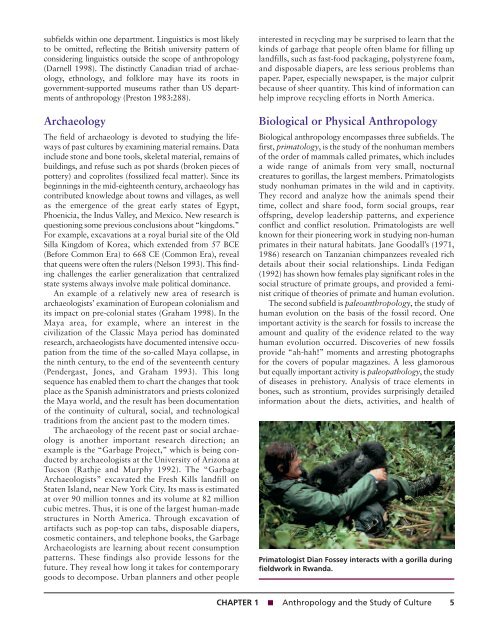PART Introduction to Cultural Anthropology - Pearson Canada
PART Introduction to Cultural Anthropology - Pearson Canada
PART Introduction to Cultural Anthropology - Pearson Canada
You also want an ePaper? Increase the reach of your titles
YUMPU automatically turns print PDFs into web optimized ePapers that Google loves.
subfields within one department. Linguistics is most likely<br />
<strong>to</strong> be omitted, reflecting the British university pattern of<br />
considering linguistics outside the scope of anthropology<br />
(Darnell 1998). The distinctly Canadian triad of archaeology,<br />
ethnology, and folklore may have its roots in<br />
government-supported museums rather than US departments<br />
of anthropology (Pres<strong>to</strong>n 1983:288).<br />
Archaeology<br />
The field of archaeology is devoted <strong>to</strong> studying the lifeways<br />
of past cultures by examining material remains. Data<br />
include s<strong>to</strong>ne and bone <strong>to</strong>ols, skeletal material, remains of<br />
buildings, and refuse such as pot shards (broken pieces of<br />
pottery) and coprolites (fossilized fecal matter). Since its<br />
beginnings in the mid-eighteenth century, archaeology has<br />
contributed knowledge about <strong>to</strong>wns and villages, as well<br />
as the emergence of the great early states of Egypt,<br />
Phoenicia, the Indus Valley, and Mexico. New research is<br />
questioning some previous conclusions about “kingdoms.”<br />
For example, excavations at a royal burial site of the Old<br />
Silla Kingdom of Korea, which extended from 57 BCE<br />
(Before Common Era) <strong>to</strong> 668 CE (Common Era), reveal<br />
that queens were often the rulers (Nelson 1993). This finding<br />
challenges the earlier generalization that centralized<br />
state systems always involve male political dominance.<br />
An example of a relatively new area of research is<br />
archaeologists’ examination of European colonialism and<br />
its impact on pre-colonial states (Graham 1998). In the<br />
Maya area, for example, where an interest in the<br />
civilization of the Classic Maya period has dominated<br />
research, archaeologists have documented intensive occupation<br />
from the time of the so-called Maya collapse, in<br />
the ninth century, <strong>to</strong> the end of the seventeenth century<br />
(Pendergast, Jones, and Graham 1993). This long<br />
sequence has enabled them <strong>to</strong> chart the changes that <strong>to</strong>ok<br />
place as the Spanish administra<strong>to</strong>rs and priests colonized<br />
the Maya world, and the result has been documentation<br />
of the continuity of cultural, social, and technological<br />
traditions from the ancient past <strong>to</strong> the modern times.<br />
The archaeology of the recent past or social archaeology<br />
is another important research direction; an<br />
example is the “Garbage Project,” which is being conducted<br />
by archaeologists at the University of Arizona at<br />
Tucson (Rathje and Murphy 1992). The “Garbage<br />
Archaeologists” excavated the Fresh Kills landfill on<br />
Staten Island, near New York City. Its mass is estimated<br />
at over 90 million <strong>to</strong>nnes and its volume at 82 million<br />
cubic metres. Thus, it is one of the largest human-made<br />
structures in North America. Through excavation of<br />
artifacts such as pop-<strong>to</strong>p can tabs, disposable diapers,<br />
cosmetic containers, and telephone books, the Garbage<br />
Archaeologists are learning about recent consumption<br />
patterns. These findings also provide lessons for the<br />
future. They reveal how long it takes for contemporary<br />
goods <strong>to</strong> decompose. Urban planners and other people<br />
interested in recycling may be surprised <strong>to</strong> learn that the<br />
kinds of garbage that people often blame for filling up<br />
landfills, such as fast-food packaging, polystyrene foam,<br />
and disposable diapers, are less serious problems than<br />
paper. Paper, especially newspaper, is the major culprit<br />
because of sheer quantity. This kind of information can<br />
help improve recycling efforts in North America.<br />
Biological or Physical <strong>Anthropology</strong><br />
Biological anthropology encompasses three subfields. The<br />
first, prima<strong>to</strong>logy, is the study of the nonhuman members<br />
of the order of mammals called primates, which includes<br />
a wide range of animals from very small, nocturnal<br />
creatures <strong>to</strong> gorillas, the largest members. Prima<strong>to</strong>logists<br />
study nonhuman primates in the wild and in captivity.<br />
They record and analyze how the animals spend their<br />
time, collect and share food, form social groups, rear<br />
offspring, develop leadership patterns, and experience<br />
conflict and conflict resolution. Prima<strong>to</strong>logists are well<br />
known for their pioneering work in studying non-human<br />
primates in their natural habitats. Jane Goodall’s (1971,<br />
1986) research on Tanzanian chimpanzees revealed rich<br />
details about their social relationships. Linda Fedigan<br />
(1992) has shown how females play significant roles in the<br />
social structure of primate groups, and provided a feminist<br />
critique of theories of primate and human evolution.<br />
The second subfield is paleoanthropology, the study of<br />
human evolution on the basis of the fossil record. One<br />
important activity is the search for fossils <strong>to</strong> increase the<br />
amount and quality of the evidence related <strong>to</strong> the way<br />
human evolution occurred. Discoveries of new fossils<br />
provide “ah-hah!” moments and arresting pho<strong>to</strong>graphs<br />
for the covers of popular magazines. A less glamorous<br />
but equally important activity is paleopathology, the study<br />
of diseases in prehis<strong>to</strong>ry. Analysis of trace elements in<br />
bones, such as strontium, provides surprisingly detailed<br />
information about the diets, activities, and health of<br />
Prima<strong>to</strong>logist Dian Fossey interacts with a gorilla during<br />
fieldwork in Rwanda.<br />
CHAPTER 1 ■ <strong>Anthropology</strong> and the Study of Culture 5
















